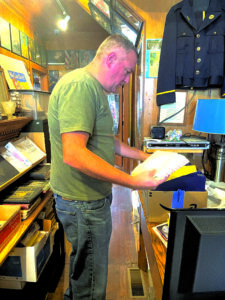Genealogist tells how to research military records

Correspondent photo / Nancilynn Gatta Tim Seman, president of the Mahoning County Chapter of the Ohio Genealogical Society, gestures to his laptop during his presentation “Military Genealogy: Uncovering Your Family’s Military Past,” on Wednesday at the St. Charles Church meeting room in Boardman. He discussed how to use obituaries to find information about family members who were veterans
BOARDMAN — The Mahoning Valley has a long history of residents who served in the military.
According to the 2019 U.S. Census Bureau’s Community Survey, nearly 10% of the population in Mahoning County and 9% of the population in Trumbull County are veterans. That is more than the state average, which is between 6% and 7%. Columbiana County has more than 10% of its population as veterans.
Tim Seman, president of the Mahoning County Chapter of the Ohio Genealogical Society, spoke at the group’s monthly meeting Wednesday at St. Charles Church in Boardman. His talk, “Uncovering Your Family’s Military Past,” was appropriate since it took place right before Veterans Day, which is Tuesday.
“I know families in Youngstown that had six kids — three sons and three daughters — and they all served in uniform in World War II. I wonder if we could do that today or even 15 or 20 years ago. They rose to the occasion,” Seman said.
He discussed his work finding information on his two uncles who served as examples on how to research military family histories.
“I had two uncles in World War II. One died in service, and the other came back a decorated war hero,” Seman said.
His research helped him understand more about his uncle who perished in the war and the older brother who did not want to talk about the war.
Most genealogy journeys begin with the people closest to us. Seman said to start with family stories, photographs, medals, letters and diaries, newspaper articles and obituaries.
He noted that obituaries could appear years after a soldier died because of the time it took to identify them. Seman mentioned his uncle, Joe Kozicki, who died in 1944 in Italy, but his obituary appeared in the newspaper in 1949 after his remains were discovered.
Much of the research is done online and is free to access with or without a Mahoning County library card.
“Ancestry.com is a site that is very familiar to most researchers. They have a vast collection of military records. If you do not have a subscription, it is free to use at the library,” Seman noted.
He suggested the following websites to begin a genealogy search: www.google.com, www.abmc.gov ( American Battle Military Commission), www.findagrave.com and www.fold3.com.
“At archives.gov, which is part of the National Archives, it has digitized 3,000 records since last year,” Seman said.
As part of his presentation, which was attended by about 30 people. he showed actual footage of his Uncle Joe’s battalion marching to the battle where he died.
“This was the free version. If I paid for a clearer view, I might be able to pick out my uncle,” Seman said.
His internet search uncovered records that showed what was in his uncle’s pockets when he was killed. The items were sent to his mother, who is Seman’s grandmother.
He said if you know the exact country and area where a soldier or nurse died, foreign countries have very good records, and have assisted in identifying the dead military personnel and respectfully burying them.


